Peziza repanda (Pezizaceae) Spreading Earth Cup
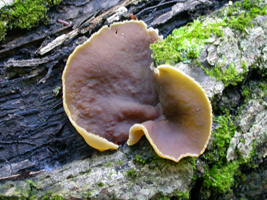 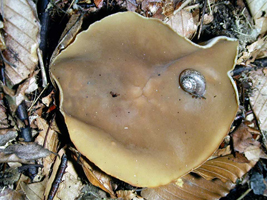
Grows scattered on rotten logs or woody humus or soil in mixed woods
Fruiting body – 6 to 10 cm wide, shallow cup expanding as it ages, becomes nearly flat with splitting margins, fertile inner surface light to medium brown, smooth to wrinkled, pale underside, no stalk
Flesh – Brittle, light tan
Spores – Clear, 15-17 x 8-10 microns, large oval, entire but finely roughened
Comments: This uncommon species grows from mid August to late September and has also been seen at the Mink River Preserve and Rock Island. |
Phaeolus schweinitzii (Polyporaceae) Dyer’s Polypore
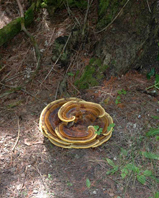    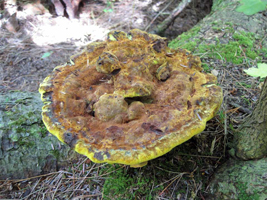
Grows solitary or grouped on roots of or under conifers
Cap – 11 cm wide, circular to fan shaped, multi-capped, broad cushion shape to shallow depressed in age, wooly matted fibers on surface when young, smoother as it ages, orange to brownish yellow or greenish yellow at margin when actively growing, rusty brown to dark brown when old, sometimes concentrically zoned
Pore surface – Decurrent, mustard yellow to greenish yellow, 1 to 3 pores per mm or joined to form larger pores near stalk, turns brown to black in age, tubes 2 to 10 mm long
Flesh – Yellowish to rusty brown, often appearing zoned
Stalk – (If present) 1 to 6 cm by 1 to 5 cm thick, often tapers downward, sometimes appearing to root, central to off-center, texture like cap
Spore print – White to yellowish-green
Spores – 5-9 x 3-5 microns, elliptical, entire
Comments: This uncommon species is difficult to identify as it goes through many color and shape changes as it develops and ages. It has only been recorded at Toft Point in August and September. |
Phlebia radiata (Corticiaceae) Pink-orange Dry Rot Fungus
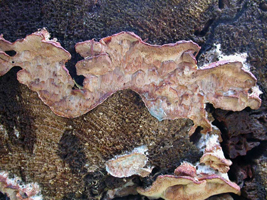 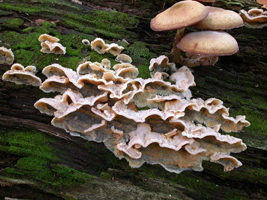
Grows as a spreading moderately thick bumpy layer on hardwood or conifer logs
Fruiting Body – Fused patches up to 30 cm long, often with smaller distinct sections of radiating wrinkles and warty veins, pink to orange-pink, margin if uplifted shows white wooly hairs.
Flesh – Thin and soft and waxy when fresh, tough and dry when aged
Spores – White or clear and difficult to obtain a print, 4-7 x 1-3 microns, elliptical to sausage shape, entire
Comments: This may be more common but was first recorded in October 2006 at Newport Park and Toft Point. It has also been seen at Peninsula Park. All sightings in Door County have been on cut fallen hardwood trees.
Aleuriduscus amorphus (Corticiaceae) Conifer Bark Fungus
I have no information on this as it was an ID by Karen Nakasone of the Forest Products Lab in Madison in the summer of 1983. It grows primarily on conifer bark of fir, spruce and Thuja plicata. |
Phlogiotis helvelloides (Tremellaceae) Apricot Jelly
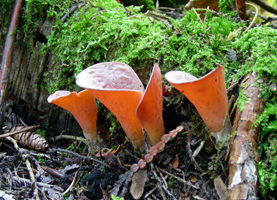  
Grows scattered to gregarious on soil under conifers
Fruiting body – 2 to 5 cm tall by 2 to 3.5 cm wide, tapering downward, shaped like a shoe horn or a funnel split down one side, rosy pink to reddish orange, smooth
Fertile surface – (Underside) smooth to lightly veined or wrinkled, a bit paler than top side
Flesh – Rubbery and a bit gelatinous
Stalk – 1 to 4 cm long, off-center or lateral, continuous with cap
Spore print – white
Spores – 9-12 x 4-6 microns, elliptical, entire
Comments: This is locally common and fruits in September. It has also been seen at Newport Park. |
Pholiota aurivella (Strophariaceae) Golden Pholiota
 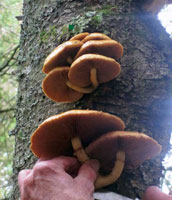  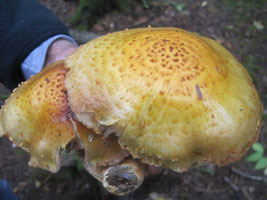
Grows in loose cespitose groups on Paper Birch and other hardwoods
Cap – 10-16 cm, broadly convex, yellow-brown with a gray-brown margin, remains of partial veil on margin, tacky to viscid, flattened brown scales
Gills – adnate to sinuate, close, medium-broad, yellow-brown to dark brown with spores, even-edged
Flesh – Medium-thick, light tan, firm
Stalk – 7-8cm by 1.2-2cm, central, cylindrical, curved, apex narrower and tan and fairly smooth, thin superior ring, scaly below ring, medium brown, base slightly enlarged
Spores – dark chocolate brown, elliptic, smooth, 8-9 X 5-6 microns
Comments: These were seen about 8 feet high on a standing Paper Birch. They have also been found at the Mink River Preserve. |
Pholiota squarrosoides (Cortinariaceae) Sharp-scaly Pholiota
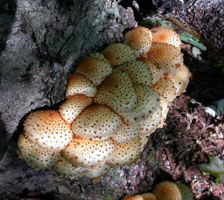 
Grows solitary but more often gregarious to cespitose on fallen paper birch trees
Cap – 3 to 6 cm, broadly convex, low broad umbo, light yellow brown, medium brown recurved scales, dry but slimy in age and wet weather, margin incurved when young
Gills – Sinuate, brown, close to crowded, medium broad
Flesh – Off-white, medium thick, nice odor
Stalk – 2.5 to 3 cm by 5 to 8 mm, tan, smooth above ring, scaly below ring, often curved, solid to pithy
Spore print – Milk chocolate brown
Spores – 6-8 x 4-5 microns, oval, entire, slightly roughened, no apical pore
Comments: This is a very common species in Door County most often found on rotting paper birch trees from mid August to early October. It has also been seen at the Mink River Preserve, Newport Park, Rock Island and Whitefish Dunes State Park. |
Piptoporus betulinus (Polyporaceae) Birch Polypore
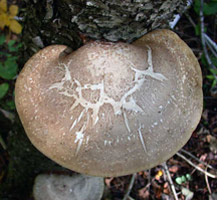 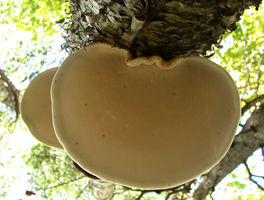 
Grows solitary or grouped on dead or dying birch trees
Cap – 4 to 15 cm wide by 2 to 6 cm deep and about 3 cm thick, broadly convex to nearly flat in age, kidney shaped to nearly round, white with tan marks, margin inrolled
Pore surface – White, 3 to 4 pores per mm, round, turns brown with age, tubes 2 to 10 mm long
Flesh – White, moderately thick, corky
Stalk – None or only an extension of the cap edge
Spore print – White
Spores – 3-6 x 1.5-2 microns, long-elliptical or sausage shape, entire
Comments: This is a common perennial found in all seasons but actively growing only in summer to early fall. It has also been seen at Mink River, Newport Park, the Ridges Sanctuary, Rock Island and Whitefish Dunes. |
Polyporus brumalis (Polyporaceae) Dark Brown Fringed Polypore
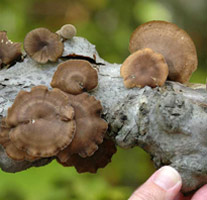 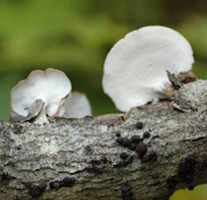 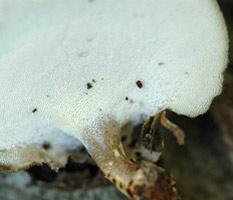
Grows solitary to clustered on dead birch and beech logs and branches
Cap – 2 to 7 cm, circular to fan shaped, slightly depressed, dark brown, furry texture, downcurved margin
Pore surface – Decurrent, cream color, yellowish in age, 3 to 4 pores per mm, angular to oblong, tubes 1 to 1.5 mm long
Flesh – White, thin
Stalk – 1 to 2 cm by 3 to 7 mm, off-center to lateral, light brown, scaly, tough
Spore print – White
Spores – 6-8 x 2-3 microns, elliptical, entire
Comments: This beautiful small polypore is fairly common and grows in September and October and has been seen at Newport Park and Whitefish Dunes. |
Pseudohydnum gelatinosum (Tremellaceae) Jelly Tooth
   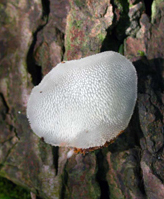 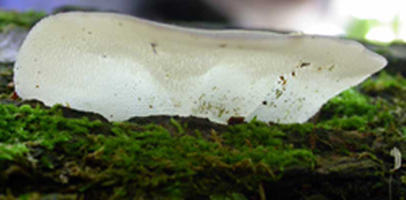
Grows solitary to scattered on rotting logs or humus under conifers
Cap – 1 to 5 cm, spoon shaped or like a shoe horn, grayish, translucent, slightly rough, gelatinous
Fertile surface – (underside) covered with small rounded spines that are flexible and 1 to 4 mm long
Flesh – Concolor, rubbery
Stalk – 3 to 5 cm long and wide, lateral, concolor
Spore print – White
Spores – 5-8.5 microns, nearly round, entire
Comments: This rare species is not easy to find, usually appearing in September, but has not been recorded since 1993. It has also been seen at Newport Park and the Ridges Sanctuary. |
Pseudoplectania nigrella (Sarcosomataceae) Black Earth Cup
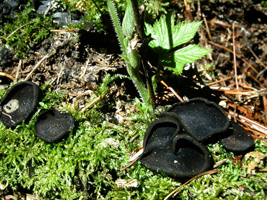
Grows solitary to scattered in moss on decaying conifer log
Fruiting body – 1.2 to 2.2 cm wide, shallow cup, inner fertile surface shiny black in wet weather, aging to dry cracked surface, sterile underside is lightly furry; no stalk
Flesh – Tan, 1.5 mm thick
Spores – Pale brown to clear, 11-12 microns, round, entire
Comments: This rare species has been reported only once in the county at Toft Point on May 13, 1995. |
Ramaria stricta (Clavariaceae) Strict Coral Mushroom
 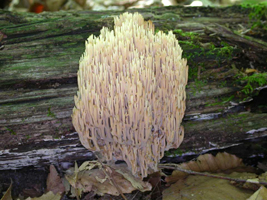 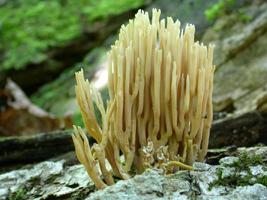
Grows scattered to gregarious on dead fallen hardwood trees
Fruiting body – 3 to 10cm tall, pale orange-tan, multi-branched, very straight upright parallel branches, tops have several blunt paler tips, each branch is 1mm wide, fragile to brittle, smooth, base up to 5cm wide
Spore print – buff to yellow
Spores – elliptical, non-amyloid, roughened, 7-10x3-5 microns
Found in late summer to fall; also seen at Mink River Preserve, Newport State Park and Whitefish Dunes State Park |
Rozites caperata (Cortinariaceae) Gypsy Mushroom
 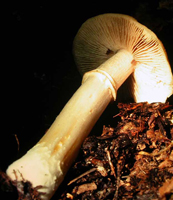
Grows scattered or clustered on soil in mixed woods
Cap – 6 to 10 cm, broadly convex to nearly flat in age with a low umbo, medium tan, radially wrinkled, parts of cap covered with fine flattened white hairs
Gills – Adnexed to sinuate, light brown, mottled with white zones as seen through 10-X hand lens, broad, close, ragged edges
Flesh – Light tan, medium thick
Stalk – 6 to 12 cm by 1 to 2 cm, equal, pale tan, median ring, solid to pithy, apex white fibrous-shaggy, smooth to fibrous-shaggy below ring
Spore print – Medium rusty brown
Spores – 11-13.5 x 7-9 microns, lemon drop shape, slightly roughened, many with one big oil drop inside
Comments: This is a fairly common species in Door County found from September to early October, but reported only twice at Toft Point on 9-27-84 and 9-4-87. It has also been seen at Meridian County Park, Mink River, Whitefish Dunes and Washington Island. |
Russula brevipes (Russulaceae) Short-stalked White Russula
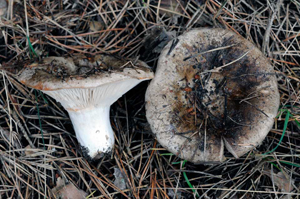 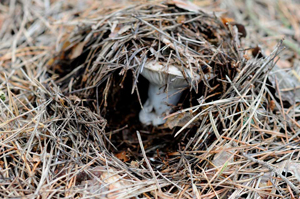 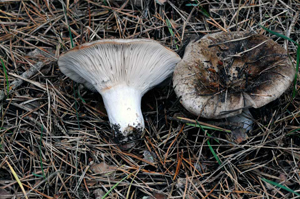
Grows widely scattered on ground in woods pushing up humus and soil into a mound
Cap – 7 to 10cm, dirty white with tan disc, concave to funnel-shaped, margin down-curved at first and uplifted in age, dry, not striate, firm texture but brittle
Gills – adnate, white, close to crowded, broad
Flesh – white, no latex when cut (looks like a Lactarius) mild-flavored, not peppery
Stalk – central, cylindrical, 3cm by 1.5 to 2.5cm, dry, smooth, tapers downward
Spore print – white
Spores – nearly round, amyloid, spiny-reticulate, 7-11 microns
It is thought that this is the species which is parasitized by the Lobster Mushroom.
Found in fall; also seen on Washington Island |
Russula emetica (Russulaceae) The Sickener
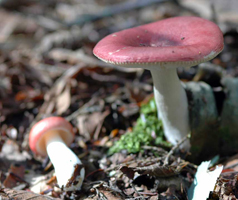
Grows solitary to very widely scattered under conifers and in bogs
Cap – 4.5 to 7.5 cm, broadly convex to funnel shape in age, deep rose to orange-red fading in age, tacky to viscid, margin faintly striate
Gills – Adnate to adnexed, white to cream, close, all equal length, some forked near stalk, some intervenose
Flesh – Off-white, thin to medium thick, acrid peppery taste
Stalk – 4 to 7 cm by 1 to 1.5 cm, central, white, dry, striate, tapers downward, pithy to hollow
Spore print – White
Spores – 8-11 microns, nearly round, reticulate, amyloid
Comments: This mushroom can be quite variable as the cap color fades with age. It is never common or abundant and might be confused with a number of other red Russula species. It may be found from mid August to mid October and has also been seen at the Mink River Preserve, Newport Park and Whitefish Dunes. |
Russula lutea (Russulaceae) Fragile Yellow Russula
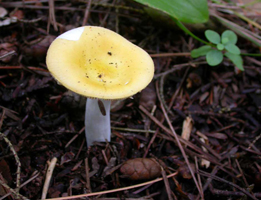  
Grows single to very widely scattered on soil in mixed woods
Cap – 3 to 5cm, deep egg yolk-yellow, broadly convex to concave, margin faintly striate, slightly tacky to dry
Gills – adnate to adnexed, yellow, equal, close to crowded
Flesh – white, medium-thin, does not turn gray when cut or bruised
Stalk – central, cylindrical, 4 to 5.5cm by 7-19mm, white, tapers upward, faintly striate, pithy to hollow
Spore print – yellow
Spores – nearly round, amyloid, spiny, 7-9 microns
Found from mid-summer to fall; also seen at Newport State Park, Ridges Sanctuary and Whitefish Dunes State Park |
Russula xerampelina (Russulaceae) Shrimp Russula
 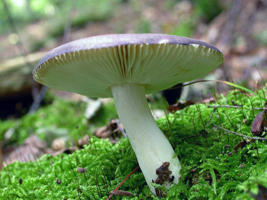 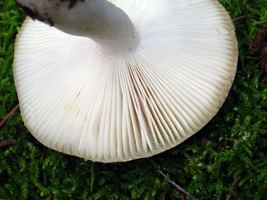
Grows single to widely scattered on soil in conifer woods
Cap – 3 to 7cm, broadly convex to concave in age, deep maroon to dusky rose or occasionally brown on disc, slightly striate, tacky to viscid when wet
Gills – adnate to adnexed, sometimes slightly sinuate, white, equal, close broad
Flesh – white, medium-thick
Spore print – yellow
Spores – nearly round, amyloid, spiny, 7-9 microns
Found from mid-summer to fall; also seen at Whitefish Dunes State Park and Ridges Sanctuary |
Spinellus fusiger (Phycomycetaceae) Pin Mold or Bonnet Mould
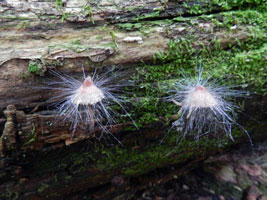 .jpg) .jpg)
This is a parasite on species of Mycena and a few other mushroom genera. It forms within the cap and then produces 1 to 3cm long narrow nearly clear spikes with a ball at the end. Once the white ball turns black the spores inside are mature and the ball will break apart and the mitospores are then carried off by wind, rain or insects.
Spores – spindle or football-shaped, smooth, 33-50 X 13-19 microns.
This species was found in two locations in northern Door County and is common in Great Britain, Ireland, parts of Europe and Asia. |
Suillus americanus (Boletaceae) American Suillus
 
Grows scattered on soil near white pines
Cap – 3 to 4cm, broadly convex, medium bright yellow with minute red flecks or streaks, viscid, smooth
Tubes – slightly decurrent, yellow, bruising brown, 4 to 5mm deep
Pores – large and angular
Flesh – yellow, thick, nice odor, maggots invade quickly
Stalk – central, cylindrical, 4 to 5.5cm by 4 to 9mm, medium yellow with brown spots, no reticulation, pithy, tough
Spore print – milk chocolate brown
Spores – elliptical, smooth, 9-11x3-4 microns
Found from mid-summer to fall; also seen at The Clearing School, Ridges Sanctuary, Whitefish Dunes, Rock Island State Park and Washington Island
|
Suillus pictus (Boletaceae) Painted Bolete
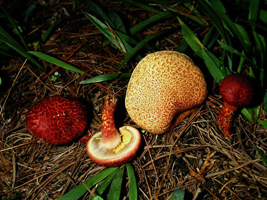 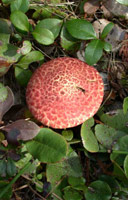 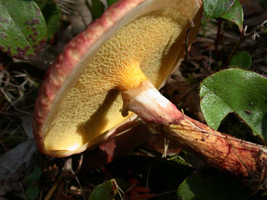
Grows solitary to scattered or grouped on soil often under white pines
Cap – 4 to 7 cm, broadly convex, dry, patches of rusty fibers over tan cuticle, broad low umbo, margin fibers are black
Pore layer – Decurrent, dull medium yellow, angular and radiating, tubes 3 mm long
Flesh – Light yellow tan, thick, nice odor
Stalk – 5 to 6 cm by 9 mm, yellow apex adorned with shallow pores above a cottony superior ring, base is 14 mm wide and is red brown and striate
Spore print –Medium brown
Spores – 7-11 x 3-4 microns, long elliptical, entire
Comments: This species is locally common in conifer forests where Eastern White Pine is abundant. It can be found from mid August to mid October and has also been seen at Mink River, Newport Park, The Ridges Sanctuary, Washington Island and Whitefish Dunes. A new species name is spraguei. |
Thelephora terrestris (Stereaceae) Earth Fan
 
Grows solitary or clustered on sandy soil in mixed woods
Cap – 3 to 7 cm tall by 3 to 8 cm wide, deep funnel, sometimes growing inside each other, purple brown with white fringed margin, thin fleshed and flexible
Fertile surface – concolor, pebbled and wrinkled with radiating lines; no flesh
Stalk – 1 cm by 3 mm, often cespitose, concolor
Spore print – Purple brown
Spores – 7-10 x 6-8 microns, fat oval, strongly tuberculate or spiny
Comments: This uncommon species blends in with the forest floor and can be overlooked. It grows from August to mid October and has also been seen at Marshall’s Point and Whitefish Dunes. |
Trametes hirsuta (Polyporaceae) Hairy Turkey Tail
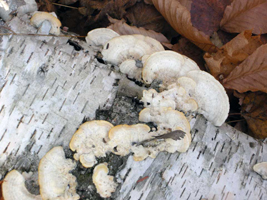  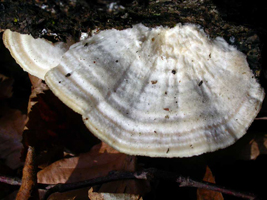
Grows in shelving united layers on dead fallen hardwoods and sometimes on conifers
Fruiting body – fan-shaped, 3 to 7cm wide by 3 to 5cm deep, gray-tan to rusty brown, zonate, furry, hygrophanous, thin, leathery, tough
Pore surface – 3 to 4 per mm, round, light yellow-tan, turns white as it dries and ages
Tubes – one layer, 1 to 5 mm deep
Flesh – white, dry, firm, 1 to 5mm thick
Spore print – white
Spores – long-elliptical, non-amyloid, smooth, 6-9x2-3 microns
Found from mid-summer to fall; also seen at Whitefish Dunes State Park, Ridges Sanctuary, Potawatomi State Park, Newport State Park, Logan Creek Preserve and Peninsula State Park |
Tricholoma terreum (Tricholomataceae) Mouse Trich
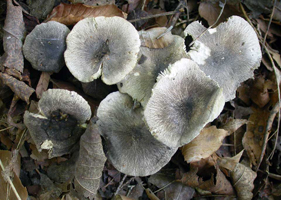 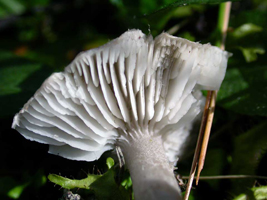
Grows scattered to densely grouped under conifers
Cap – 2 to 6 cm, broadly convex to flat with low umbo, medium gray with paler margin and a dark gray umbo adorned with black tiny matted fibers, not hygrophanous, viscid but sometimes faintly striate
Gills – Sinuate, light gray, close, broad
Flesh – Light gray, medium thin, no odor
Stalk – 3 to 6 cm by 4 to 10 mm, light gray, tapers upward, finely striate, pithy to hollow
Spore print – White
Spores – 6-8 x 3.5-5.5 microns, elliptical, entire
Comments: This species is one of the more common Tricholomas. It can be found from early September to late October and has also been seen at Newport State Park. |
Tricholoma vaccinum (Tricholomataceae) Russet-scaly Trich
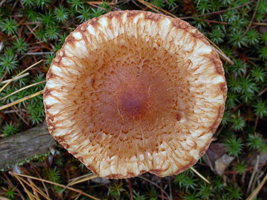 
Grows scattered on soil under conifers
Cap – 3 to 7 cm, broadly convex to flat with a low umbo, medium yellow-brown surface covered with orange-brown fibers, dry
Gills – Sinuate, light tan to orange brown in age, close, very broad
Flesh – White to light tan, thick only at disk
Stalk – 4.5 to 7.5 cm by 7 to 13 mm, apex light tan and pruinose with medium-brown fibers, slightly ventricose shape, cartilaginous, dry, pithy to hollow
Spore print – White
Spores – 5.5-7.5 x 4-5 microns, elliptical, entire
Comments: This species has only been reported twice in Door County, both at Toft Point on 9-25-01 and 10-20-06. |
Tricholomopsis sulfureoides (Tricholomataceae) No common name
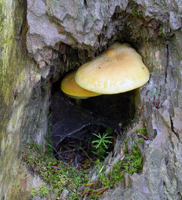 
Grows scattered to gregariously on fallen Eastern Hemlock trees
Cap – 2.5 to 7 cm, broadly convex with a small umbo, deep yellow to medium yellow-brown, smooth, hygrophanous, incurved faintly fringed margin at first
Gills – Adnate to slightly notched, concolor, close, very broad
Flesh – Dull yellow, medium thick
Stalk – 2 to 4 cm by 5 to 7 mm, concolor, flexuous, smooth, tough and cartilaginous, pithy to hollow
Spore print – White
Spores – 5-8 x 5-6 microns, nearly round, entire, non-amyloid
Comments: This is a rare species found only once at Toft Point on October 20, 2006 and once at Mink River on October 1, 2006. |
Tylopilus felleus (Boletaceae) Bitter Bolete
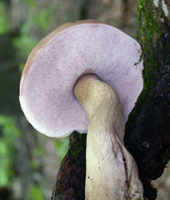 
Grows solitary to scattered on soil or moss under conifers or on well rotted conifers
Cap – 5 to 7 cm, convex to nearly flat, medium pink brown, dull, dry, no sheen, margin uplifted and split in age
Pore layer – Depressed-attached, pink brown, pores 2 mm wide and round to oval, tubes up to 15 mm long
Flesh – White, thick, bitter taste
Stalk – 5 to 9 cm by 10-22 mm, apex has dark brown network pattern over light tan undersurface, lower half medium brown, smooth-striate, pithy to hollow
Spore print – Pink brown
Spores – 11-15 x 3-6 microns, long-elliptical to spindle shaped, entire
Comments: This rather common species is found from late July to mid September and has also been seen at Mink River, Newport Park and Whitefish Dunes. |
Xeromphalina campanella (Tricholomataceae) Mossy Stump Agaric
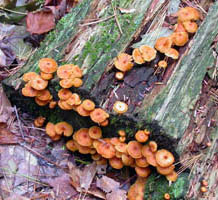 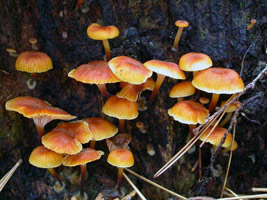 
Grows gregariously on well-rotted moss-covered conifer stumps
Cap – 1 to 2.5 cm, hemispheric and deep orange when young, nearly flat and medium orange when mature, umbilicate, slightly striate in age
Gills – Decurrent, orange, sub-distant, broad, a few forking, some intervenose
Flesh – Orange, very thin
Stalk – 1.2 to 3.5 cm by 1 to 3 mm, apex concolor with gills, lower part rich deep orange-brown, tapers downward, smooth to finely pruinose
Spore print – White
Spores – 6-8 x 3-4 microns, elliptical, entire, amyloid
Comments: This species is easily recognized by its manner of growth, orange color and habitat on mossy conifer stumps. It has been found from late August to late October, mostly at Toft Point, but may occur in other coniferous woodlands. The old genus name was Omphalina. |

